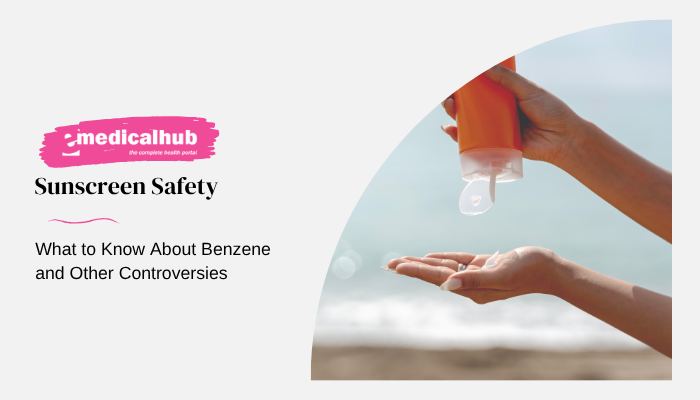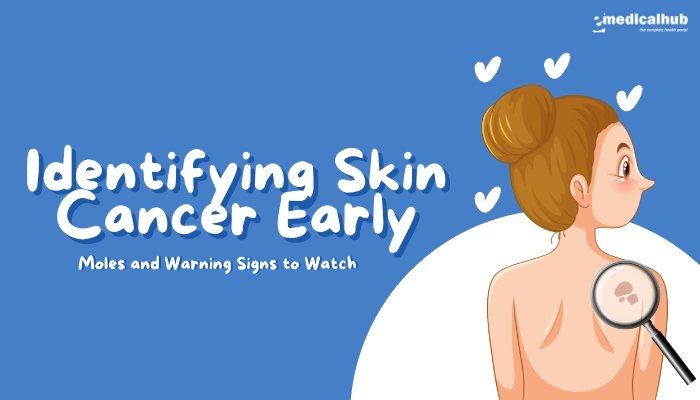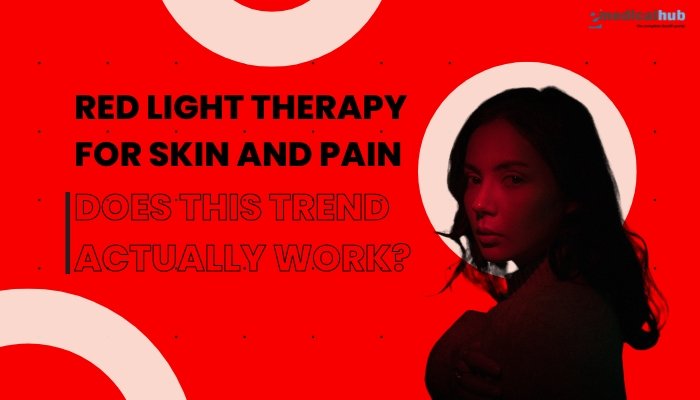Introduction
For decades, sunscreens have served as a primary defense against the harmful effects of ultraviolet (UV) radiation, reducing the risk of sunburn, premature skin aging, and skin cancer. However, recent discoveries and media coverage of contaminants, chemical absorption, and environmental impacts have stirred debates about whether sunscreen ingredients are entirely safe.
One notable controversy involves benzene—an industrial chemical detected as a contaminant in certain sunscreen products—and the ongoing discussion of possible health ramifications.
This article provides a deep dive into sunscreen safety issues. We’ll explore the discovery of benzene contamination, how it may have occurred, regulatory responses, and potential health concerns. We also discuss other topics, including chemical vs. mineral sunscreen controversies, alleged endocrine disruptors, and reef-safe concerns.
Our objective is to equip you with evidence-based information, allowing you to make informed decisions about sun protection. Always consult a qualified healthcare professional for personalized guidance, especially if you have skin sensitivities or conditions like photosensitivity.
Why Sunscreen Matters
The Importance of UV Protection
Exposure to ultraviolet (UV) radiation from the sun—specifically UVA and UVB rays—can damage skin cells’ DNA. Over time, excessive or unprotected exposure increases the risk of photoaging (wrinkles, sun spots) and various forms of skin cancer (basal cell carcinoma, squamous cell carcinoma, and melanoma). Using sunscreen with adequate SPF (Sun Protection Factor) helps:
- Prevent Sunburn: Sunburn is a clear sign of acute skin damage, raising the risk of skin cancer if repeated frequently.
- Reduce Skin Cancer Risks: Numerous studies link regular sunscreen usage to a lower incidence of squamous cell carcinoma and possibly melanoma.
- Minimize Photoaging: Sunscreen preserves collagen and elastin by filtering out UVA rays that penetrate deeper into the dermis.
Modern Sunscreen Forms
- Chemical Sunscreens: Contain organic (carbon-based) compounds—e.g., avobenzone, oxybenzone, octinoxate—that absorb UV rays, converting them into heat and releasing them from the skin.
- Mineral (Physical) Sunscreens: Typically use zinc oxide or titanium dioxide. These reflect or scatter UV rays.
- Hybrid Formulations: Combine both chemical and mineral filters for broad-spectrum coverage.
Given their widespread utility, any safety concern—like benzene contamination or ingredient hazards—draws significant consumer attention and regulatory scrutiny.
Benzene in Sunscreen: The Controversy
What Is Benzene?
Benzene is a volatile, colorless liquid chemical found in crude oil, gasoline, and cigarette smoke. Widely recognized as a carcinogen (cancer-causing substance) at high levels or chronic exposure, benzene can affect bone marrow and blood-forming cells. The U.S. Food and Drug Administration (FDA) and other health agencies set strict limits on benzene levels in consumer products to reduce cancer risk.
Discovery of Benzene Contamination
In 2021, an independent laboratory announced that it had detected benzene in certain sunscreen sprays and lotions from various brands. While not an intentionally added ingredient, it appeared as a contaminant. The impetus for testing was a general push to screen consumer products for unintended chemicals. Among the findings:
- Certain Batches Exceeding FDA Limits: Some sunscreen products showed benzene levels above the FDA’s recommended limit of 2 parts per million (ppm) for drugs and cosmetics, intended to reflect unavoidable contamination in manufacturing.
- Recall and Warnings: A few major brands voluntarily recalled specific batches or product lines to address concerns.
Possible Sources of Contamination
- Manufacturing Processes: Solvents used in production might be contaminated with small amounts of benzene if not refined properly.
- Propellants: Aerosol sprays use propellants (e.g., butane, propane, isobutane). Inadequate purification could introduce benzene.
- Packaging and Storage: Rarely, chemical reactions or poor storage might degrade certain ingredients, forming traces of benzene, although this is less likely.
Health Concerns Around Benzene
- Carcinogenicity: Chronic benzene exposure is associated with leukemia and other blood disorders if inhaled or ingested at significant levels.
- Skin Absorption: While short-term topical exposure to minimal amounts of benzene is less well studied, repeated use of a contaminated product could pose unknown risks.
- Regulatory Perspective: The FDA maintains that no level of avoidable benzene is truly safe, given its carcinogenic nature, but sets an upper threshold for “unavoidable” presence at 2 ppm under certain circumstances.
Regulatory and Industry Responses
FDA Guidance
The FDA has not banned sunscreens featuring traces of benzene, but it expects manufacturers to comply with good manufacturing practices, ensuring contaminants stay below recognized safety limits. After the contamination revelations:
- Recall Announcements: Some companies recalled products with benzene levels significantly above 2 ppm.
- Increased Testing: The FDA and many companies now test raw materials and final products more rigorously to detect accidental benzene.
Industry Adjustments
- Reformulation: Brands reliant on aerosol propellants are exploring safer alternatives or improved purification methods.
- Transparency: Many manufacturers provide batch testing results or third-party certifications to regain consumer trust.
- Consumer Education: Companies stress that using contaminated sunscreen is still safer than no UV protection, though the ideal scenario is zero benzene contamination.
Consequences for Consumers
While recalls and lab analyses left some consumers worried, dermatologist organizations continue to emphasize the importance of consistent sunscreen use. The risk from an occasional benzene trace in sunscreens is deemed relatively small compared to the proven harm of UV exposure—yet ensuring minimal contamination is a goal for both consumer safety and manufacturer responsibility.
Controversies Over Chemical Sunscreens
Aside from benzene, chemical sunscreens have faced scrutiny for potential endocrine disruption, coral reef damage, and systemic absorption.
Endocrine Disruptors?
- Oxybenzone and Octinoxate: These filters have shown hormone-like activity in laboratory settings, raising concerns about effects on human endocrine systems. Critics highlight rodent studies suggesting possible reproductive or developmental harm.
- Human Relevance: The FDA has asked for more data, but as of now, conclusive evidence of hormonal harm in humans from typical sunscreen use is lacking. Levels found in the bloodstream have been documented, but whether they are harmful is under debate.
Systemic Absorption
Recent studies confirm that some chemical filters (e.g., avobenzone, oxybenzone) can be detected in the bloodstream after repeated application. The significance of these detectable levels remains unclear, prompting further research on potential long-term consequences.
Coral Reef Damage
- Reef-Safe Movement: Sunscreen chemicals like oxybenzone and octinoxate are associated with coral bleaching in lab studies. Some tourist destinations (e.g., Hawaii, certain areas of Mexico) have banned sunscreens containing these filters in an effort to protect marine life.
- Mineral Alternatives: Non-nano zinc oxide and titanium dioxide are often recommended as “reef-safe” options. However, whether these are truly safe for coral can also depend on particle size and formulation.
Conclusion: While controversies about potential endocrine effects, systemic absorption, and reef safety swirl, many health authorities still assert that the protective benefits of sunscreen generally outweigh theoretical or unproven risks. Further studies may shape future regulation.
Mineral (Physical) Sunscreens: Are They Safer?
As an alternative to potentially controversial chemicals, mineral sunscreens (zinc oxide, titanium dioxide) reflect UV rays rather than absorbing them. They have a few highlights and drawbacks:
Pros
- Gentle on Sensitive Skin: Less likely to cause irritation or allergic reactions.
- Immediate Protection: Effective as soon as applied, no 15-minute wait needed.
- Lower Systemic Absorption: Large mineral particles remain mostly on the skin’s surface, leading to minimal bloodstream penetration.
Cons
- White Cast: Traditional formulas can leave a visible white/grayish tint on the skin, particularly for darker skin tones.
- Thicker Application: Some find the texture heavy or pasty, though newer micronized or tinted products mitigate this issue.
- Environmental Impact: Nano-sized titanium dioxide or zinc oxide might pose marine toxicity concerns, though evidence is less established than for oxybenzone.
Ultimately, mineral-based sunscreens remain a recommended choice for young children, pregnant women, or those with sensitive or compromised skin.
Best Practices for Safe Sunscreen Use
Choose Broad-Spectrum
Look for “broad-spectrum” on the label, meaning coverage against both UVA (aging rays) and UVB (burning rays). This ensures comprehensive protection from short- and long-term skin damage.
Consider SPF 30 or Higher
Experts, including the American Academy of Dermatology, advise using at least SPF 30. Higher SPFs provide incremental benefits (SPF 50 blocks about 98% of UVB, vs. 97% for SPF 30). More important is regular reapplication.
Reapply Every Two Hours (or After Swimming)
Reapplication is often neglected yet crucial. Sweat, water, and daily activity degrade sunscreen’s effectiveness. Even “water-resistant” sunscreens typically maintain efficacy for only 40–80 minutes in water.
Apply Enough Product
Most under-apply. A general rule is about 1 ounce (a shot glass worth) for full-body coverage on an adult wearing a swimsuit. For the face alone, a nickel- to quarter-sized dollop is recommended.
Spray vs. Lotion
Spray sunscreens are convenient but more prone to inhalation, incomplete coverage, or contamination with propellants. If you use sprays:
- Hold Close: Spray near the skin and rub it in thoroughly.
- Avoid Windy Areas: Minimizes drift or inhalation.
- Check Recalls: Some spray sunscreens were among those found to have benzene contamination.
Combine with Other Protective Measures
Relying on sunscreen alone might lead to incomplete coverage. For robust protection:
- Clothing: UPF-rated garments, hats, and sunglasses block additional UV exposure.
- Shade: Limit direct midday sun (10 a.m. to 4 p.m.).
- Healthy Habits: Avoid tanning beds, do regular self-checks for suspicious moles.
How to Identify Safe, Quality Sunscreens
Look for Reputable Seals
- FDA-Approved Labeling: In the U.S., sunscreens are classified as over-the-counter (OTC) drugs, with regulated claims about SPF and water resistance.
- Dermatologist Associations: Some carry official seals from recognized organizations, e.g., the Skin Cancer Foundation’s Seal of Recommendation.
Avoid Unverified Health Claims
Sunscreens that claim to be “chemical-free” or “100% non-toxic” can be marketing hype. Even “natural” mineral filters are still chemicals in a broad sense. Instead, check for recognized active filters and legitimate broad-spectrum labeling.
Check for Recalls or Testing
- Consumer Tools: Some independent labs publish lists of tested sunscreens verifying benzene levels or verifying SPF claims.
- Brand Transparency: Companies can provide batch testing or raw materials data upon request.
FAQ: Addressing Common Concerns
- Should I stop using sunscreen due to benzene fears?
No. The consensus is that the risk from unprotected sun exposure significantly exceeds that from potential trace benzene contamination. Simply choose reputable brands, monitor recalls, and use caution with aerosol products if worried. - Is it safe to use last year’s sunscreen?
Most sunscreens have a shelf life of around two to three years, but heat or direct sunlight can degrade them faster. Check the expiration date, color, or smell. If uncertain, replace it. - Are baby sunscreens actually different?
Children’s formulas often rely on mild physical filters like zinc oxide, avoiding fragrances or potential irritants. Infants under 6 months are generally recommended to avoid direct sunlight or rely on protective clothing rather than sunscreen unless advised by a doctor. - How do I confirm if a product is “reef-friendly”?
Look for labels stating “reef-safe” or “Hawaii-compliant,” meaning no oxybenzone or octinoxate. Some local laws also ban avobenzone, so check local regulations if traveling. - Are tanning oils with SPF beneficial?
Tanning oils typically have minimal SPF, often <15, providing inadequate UVA/UVB protection. They can mislead users into extended sun exposure and increased burn risk.
Additional Controversies in Sunscreen
Spray Inhalation Concerns
Spray sunscreens carry inhalation risks for children or those around them. Over-spraying in enclosed spaces or windy conditions might deliver aerosolized chemicals into the lungs. Experts recommend applying in a well-ventilated area, spraying onto hands, then rubbing onto the skin—especially for children.
SPF Over 50?
Some product lines claim SPF 75 or 100+. The FDA has debated capping SPF labeling at 50 or 60, as real-world differences above that threshold are marginal. The possibility is that high SPF numbers foster complacency, leading users to skip reapplication.
Tanning Accelerators or “Natural Tanning” Products
Products that promise a “healthy tan” or accelerated tanning without mention of sun protection can be misleading. A tan inherently suggests skin damage. No tanning accelerator effectively blocks harmful UV rays.
Email Harms?
Allegations of sunscreen chemicals interfering with electronics or phone signals are unsubstantiated. No credible evidence suggests that wearing sunscreen affects device performance or connectivity.
Navigating Misinformation Online
While staying updated about recalls and new research is wise, it’s easy to fall victim to alarmist social media posts about “toxic” sunscreens or benign alternatives that “do nothing.” Some tips:
- Check Primary Sources: Peer-reviewed journals, FDA statements, and recognized health organizations (e.g., American Academy of Dermatology).
- Spot Red Flags: Overblown claims that a single ingredient causes all harm or that a product is “100% chemical-free” are usually marketing or misinformation.
- Professional Advice: Dermatologists remain the best resource for individualized questions, especially if you have allergies or existing conditions.
Current Research and Future Directions
Ongoing Studies
Researchers continue evaluating:
- Long-Term Chemical Absorption: Large-scale human studies to see if repeated daily application of chemical filters has measurable endocrine or carcinogenic impact.
- Benzene Thresholds: Whether FDA’s existing 2 ppm limit remains adequate or if zero tolerance is feasible.
- Alternative Filters: Novel UV blockers with improved safety or reef-friendly profiles, possibly derived from marine organisms or advanced materials.
Potential Regulatory Changes
- Label Overhaul: Some propose more explicit ingredient disclosures or standardized “reef-safe” definitions.
- Global Harmonization: Different regions have varied allowed filters and SPF rules. A unified approach could reduce confusion.
Formulation Innovations
- Sheer Minerals: Next-gen physical sunscreens designed to reduce white cast while maintaining strong UVA/UVB coverage.
- Lotion-Gel Hybrids: Lighter textures that spread easily, encouraging consistent use.
- Smart Packaging: UV sensor packaging or real-time color-change technology to show when reapplication is due.
Conclusion
Sunscreen remains a cornerstone in the fight against sunburn, premature aging, and skin cancer. Despite controversies around benzene contamination, chemical filter absorption, and reef safety, experts affirm that the harm from unprotected sun exposure far outweighs potential downsides—provided you select products thoughtfully and follow best practices.
When choosing a sunscreen, weigh your skin type, your environment (e.g., reef-safe if snorkeling in tropical waters), and brand transparency about ingredient sourcing. Mineral-based sunscreens remain a dependable option for those wary of chemicals or with sensitive skin. Thorough application, reapplication, and additional measures (clothing, shade) are vital to actual protection.
As research evolves, manufacturers and regulators continue refining sunscreen safety and efficacy. Keep an eye out for recall notices and verified lab analyses regarding contaminants like benzene. Ultimately, the most important step is consistent, correct sunscreen usage to guard your skin’s health in every season—while staying informed of emerging data and recommended guidelines.
References
- Green A, Williams G, Logan V, et al. Reduced melanoma after regular sunscreen use: randomized trial follow-up. J Clin Oncol. 2011;29(3):257-63.
- Wang SQ, Balagula Y, Osterwalder U. Photoprotection: a review of the current and future technologies. Dermatol Ther. 2010;23(1):31-47.
- Matta MK, Florian J, Zusterzeel R, et al. Effect of sunscreen application on plasma concentration of sunscreen active ingredients: a randomized clinical trial. JAMA. 2020;323(3):256-267.
- Krause M, Klit A, Blomberg Jensen M, et al. Sunscreens: are they beneficial for health? An overview of endocrine disrupting properties of UV-filters. Int J Androl. 2012;35(3):424-36.
- Downs CA, Kramarsky-Winter E, Segal R, et al. Toxicopathological effects of the sunscreen UV filter, oxybenzone (benzophenone-3), on coral planulae. Arch Environ Contam Toxicol. 2016;70(2):265-88.
- Food and Drug Administration (FDA). Sunscreen drug products for over-the-counter human use; proposed amendments of final monograph. Fed Regist. 2019;84(38):6204-6275.
- Valisure. Valisure finds benzene in sunscreens. Valisure.com. Published online May 2021.
- Lichtenfeld JL, Freedman AM. Understanding the impact of benzene contamination in sunscreens. Cancer Prev Res. 2021;14(9):823-825.
- The American Academy of Dermatology. Sunscreen FAQs. AAD.org. Accessed 2023.
- Norval M, Wulf HC. Does chronic sunscreen use reduce vitamin D production to insufficient levels? Br J Dermatol. 2009;161(4):732-6.
- Bonda C, Shulman JD. Labeling and marketing of “reef safe” sunscreen: Current controversies and future directions. Clin Dermatol. 2021;39(5):831-838.
- Stiefel C, Schwack W. Photoprotection in changing times—UV filter developments, uncertainties, and controversies. Cosmetics. 2022;9(2):37-45.




